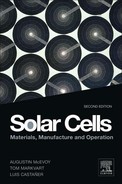Book Description
Enormous leaps forward in the efficiency and the economy of solar cells are being made at a furious pace. New materials and manufacturing processes have opened up new realms of possibility for the application of solar cells. Crystalline silicon cells are increasingly making way for thin film cells, which are spawning experimentation with third-generation high-efficiency multijunction cells, carbon-nanotube based cells, UV light for voltage enhancement, and the use of the infrared spectrum for night-time operation, to name only a few recent advances.
This thoroughly updated new edition of Markvart and Castaner’s Solar Cells, extracted from their industry standard Practical Handbook of Photovoltaics, is the definitive reference covering the science and operation, materials and manufacture of solar cells. It is essential reading for engineers, installers, designers, and policy-makers who need to understand the science behind the solar cells of today, and tomorrow, in order to take solar energy to the next level.
- A thorough update to the definitive reference to solar cells, created by a cast of international experts from industry and academia to ensure the highest quality information from multiple perspectives
- Covers the whole spectrum of solar cell information, from basic scientific background, to the latest advances in materials, to manufacturing issues, to testing and calibration.
- Case studies, practical examples and reports on the latest advances take the new edition of this amazing resource beyond a simple amalgamation of a vast amount of knowledge, into the realm of real world applications
Table of Contents
- Cover image
- Title page
- Table of Contents
- Copyright
- List of Contributors
- Part IA: Solar Cells
- Chapter IA-1. Principles of Solar Cell Operation
- Chapter IA-2. Semiconductor Materials and Modelling
- 1 Introduction
- 2 Semiconductor Band Structure
- 3 Carrier Statistics in Semiconductors
- 4 The Transport Equations
- 5 Carrier Mobility
- 6 Carrier Generation by Optical Absorption
- 7 Recombination
- 8 Radiation Damage
- 9 Heavy Doping Effects
- 10 Properties of Hydrogenated Amorphous Silicon
- Acknowledgements
- References
- Chapter IA-3. Ideal Efficiencies
- Part IB: Crystalline Silicon Solar Cells
- Part IC: Thin Film Technologies
- Chapter IC-1. Thin-Film Silicon Solar Cells
- Chapter IC-2. CdTe Thin-Film PV Modules
- Chapter IC-3. Cu(In,Ga)Se2 Thin-Film Solar Cells
- Chapter IC-4. Progress in Chalcopyrite Compound Semiconductor Research for Photovoltaic Applications and Transfer of Results into Actual Solar Cell Production
- Chapter IC-5. High-Efficiency Back-Contact Silicon Solar Cells for One-Sun and Concentrator Applications
- 1 Introduction
- 2 Concentrator Applications of IBC Solar Cells
- 3 Back-Contact Silicon Solar Cells
- 4 Modelling of Back-Contact Solar Cells
- 5 Perimeter and Edge Recombination
- 6 Manufacturing Process for Back-Contact Solar Cells
- 7 Stability of Back-Contact Cells
- 8 Toward 30% Efficiency Silicon Cells
- 9 How to Improve the Efficiency of Back-Contact Solar Cells
- 10 Conclusions
- Acknowledgements
- References
- Chapter IC-6. High Efficiency III–V Multijunction Solar Cells
- Part ID: Dye-Sensitized and Organic Solar Cells
- Part II: Testing, Industry and Environment
- Part IIB: Environment
- Chapter IIB-1. Overview of Potential Hazards
- 1 Introduction
- 2 Overview of Hazards in PV Manufacture
- 3 Crystalline Silicon (x-Si) Solar Cells
- 4 Amorphous Silicon (a-Si) Solar Cells
- 5 Cadmium Telluride (CdTe) Solar Cells
- 6 Copper Indium Diselenide (CIS) Solar Cells
- 7 Gallium Arsenide (GaAs) High-Efficiency Solar Cells
- 8 Operation of PV Modules
- 9 Photovoltaic Module Decommissioning
- 10 Conclusion
- References
- Editor's Note
- Chapter IIB-1. Overview of Potential Hazards
- Part IIC: Industry
- Appendix A: Constants, Physical Quantities, and Conversion Factors
- Appendix B: List of Principal Symbols
- Appendix C: Abbreviations and Acronyms
- Appendix D: Useful Web Sites and Journals
- Appendix E: International Standards with Relevance to Photovoltaics
- Appendix F: Books About Solar Cells, Photovoltaic Systems, and Applications
- Index
